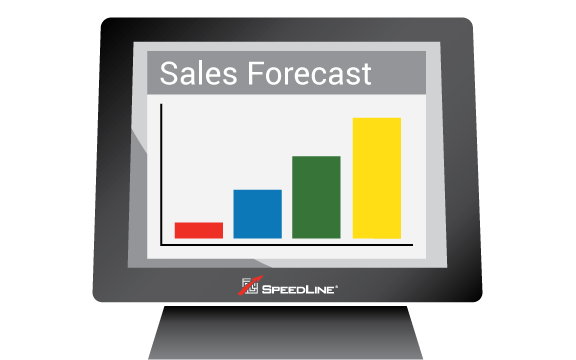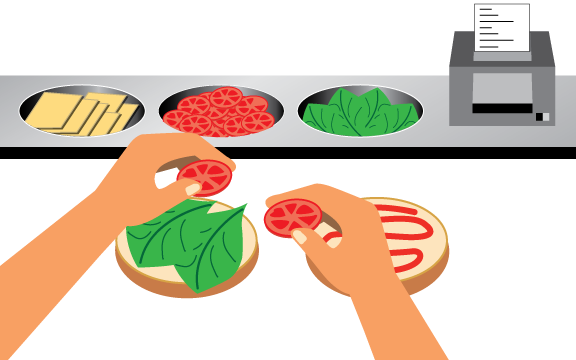Controlling food costs is an ongoing challenge for every pizza and delivery restaurant operator. From food waste, to theft, to over portioning, many factors influence overall food costs. The right point of sale system can give you a new level of control over many of these factors.
1. Portion Control
For any restaurant chain, delivering a consistent product across multiple locations is critical, and even for an independent operator, portion control is a significant factor in controlling food cost and delivering a consistent product. Standardized recipes in your point of sale can help ensure this level of consistency, and protect restaurant margins.
Weights & Measures
One popular method of enforcing potion control is to weigh everything. Another is to use portion cups, much like measuring cups, that fill to the exact amount needed of an ingredient on a menu item. Some restaurants even choose to mix the two methods, using scales for proteins and portion cups for vegetables.
Pre-portioning during prep can support consistency and save time on the make line. The more vigilant you are with portion control, the more tightly you can manage food costs—because there is no way around it: free-handing toppings typically results in over-portioning, inconsistency, and waste.
We're portioning using a cup on scales, and it's a never-ending battle. Employees don't like to do it. I kind of get why on rushes. I get it. But they never get good at it if they're not doing it when it's slow. But yeah, we portion. We saw, I think, we had an aha moment probably 13, 14 years ago at the pizza expo. I think it was Big Babe Ostrander, and he did the math. And we were just like, "Whoa."
And so, I know that, when I'm not there and it's Friday night, and we're getting absolutely crushed, I know they're free handing. But I also know that, when they're using the cups the other six days out of the week, or let's say the rest of the day, when it's not slammed, they know what a pizza's supposed to look like. Is it going to be perfect when they free-hand it? No. But at least there's been some training and they're not just brought in and say, "Here, put cheese on there."
- Greg Thomas, owner of Mama Roni's Pizza in Doing More with Less: Dealing with a Labor Shortage
2. Recipes on Make Tickets
Take portion control a step further by ensuring the recipes are easy for your staff to find.
Does your POS system allow you to print weights and measures on your make tickets (or show them on the kitchen display)? This is particularly useful if you have create-your-own menu items or lots of exceptions—which is the norm in the pizza business.
The make ticket reinforces, for example, that the correct amount of pepperoni to use on a large 1-topping pizza is 5 ounces, while only 3 ounces should go on a large 4-topping. Learn more about make tickets in Portion Control: Reduce Inventory Costs in Your Pizzeria.
3. Inventory
Inventory is cash on your shelves. Waste, over-stocking, theft and spoilage come off the bottom line—often to the tune of thousands of dollars per year. But inventory tracking software can identify where this shrink is happening so you can eliminate it. Unfortunately, most restaurant operators haven’t made the time investment to set up inventory software—or they are struggling with an inventory application that’s poorly suited to their restaurant concept.
This is a particular issue for pizza. Menu items built on the fly like these are an impossible challenge for traditional inventory applications that require you to define a recipe for every possible combination. So it’s critical to use an application such as SpeedLine Inventory that is capable of tracking ingredient usage accurately for create-your-own pizzas and half-and-half orders.
A pizza-specific inventory application calculates topping usage-based not only on pizza size, but also on the number of toppings on the pizza. These tools also deliver accurate inventory control for build-your-own sandwiches, pastas, and salads.
4. Forecasting
Without the proper tools and resources in place, even a well-conceived business plan can fail. Savvy restaurant operators forecast not only monthly, but daily and weekly sales to plan accurately for efficient prep, appropriate staffing, and profitable promotions.

SpeedLine POS, builds a forecast dynamically based on sales history. You can then review daily notes in the system and update the forecast to reflect your best knowledge of parties, local events, weather, or other things that may impact sales today or this week.
The finished forecast feeds sales projections into your labor and prep plans, based on forecasted sales for any daypart—even breaking it down to show you projected sales for delivery at lunchtime or dine-in at dinner.

5. Prep Planning
Ever have to throw away a significant amount of food at the end of the night?

Accurate planning doesn’t need to be a tedious manual process. SpeedLine POS can recommend detailed food prep plans based on your forecasted sales for the day. Realistic numbers significantly reduce your risk of waste caused by under- or over-prepping.
If your concept includes a buffet, accurate prep planning can be even more critical. A POS system that also projects buffet usage, prints a prep template for the buffet, and tracks actual buffet usage in inventory can shave points off your food cost at the buffet.
Posted on Mon, Mar 02, 2020 @ 08:03 AM.
Updated on June 22, 2022 @ 4:31 PM PST.


